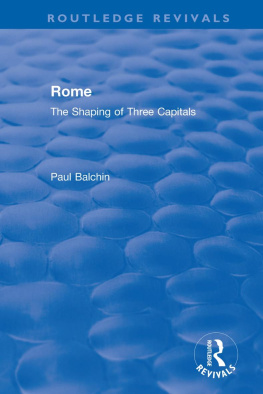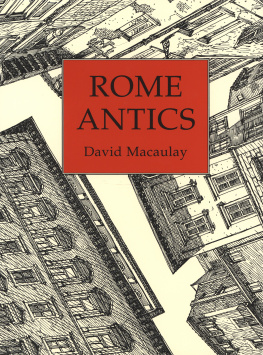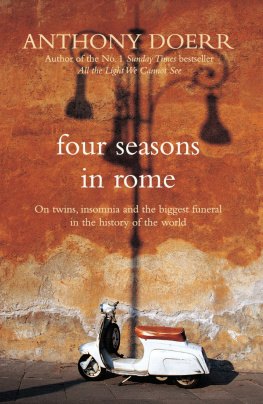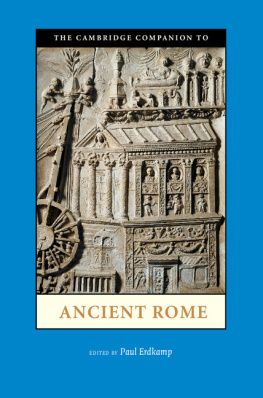Routledge Revivals
Rome
First published in 2017, Rome: The Shaping of Three Capitals explores the impact of political history on the built environment of the Eternal City.
The book divides Romes history into three main periods: the rulership of the early kings from the 8th to the 6th centuries BC; the period of Etruscan culture and architecture up to the end of the Roman Empire in 5th century AD; and, the 6th century to 1870, when Rome stood as the ecclesiastical capital of the Catholic Church and the temporal state of the Papal States. The final section of the book examines the Risorgimento, the unification of Italy, and the development of the fascist state; a time when Rome became the capital of Italy and endeavoured to establish a new empire.
Exploring political instability and change, Balchin demonstrates the strong connection between politics and the physical shaping of the city through an examination of the successive styles of architecture, from Classical to Modernist.
Rome
The Shaping of Three Capitals
By Paul N. Balchin
First published in 2017
by Troubador Publishing Ltd.
This edition first published in 2020 by Routledge
2 Park Square, Milton Park, Abingdon, Oxon, OX14 4RN
and by Routledge
52 Vanderbilt Avenue, New York, NY 10017
Routledge is an imprint of the Taylor & Francis Group, an informa business
Copyright 2017 Paul N. Balchin
All rights reserved. No part of this book may be reprinted or reproduced or utilised in any form or by any electronic, mechanical, or other means, now known or hereafter invented, including photocopying and recording, or in any information storage or retrieval system, without permission in writing from the publishers.
Publishers Note
The publisher has gone to great lengths to ensure the quality of this reprint but points out that some imperfections in the original copies may be apparent.
Disclaimer
The publisher has made every effort to trace copyright holders and welcomes correspondence from those they have been unable to contact.
ISBN 13: 978-0-367-52063-2 (hbk)
ISBN 13: 978-1-003-05639-3 (ebk)
ROME
The Shaping of Three Capitals
Paul N Balchin
Copyright 2017 Paul N Balchin
The moral right of the author has been asserted.
Apart from any fair dealing for the purposes of research or private study, or criticism or review, as permitted under the Copyright, Designs and Patents Act 1988, this publication may only be reproduced, stored or transmitted, in any form or by any means, with the prior permission in writing of the publishers, or in the case of reprographic reproduction in accordance with the terms of licences issued by the Copyright Licensing Agency. Enquiries concerning reproduction outside those terms should be sent to the publishers.
Matador
9 Priory Business Park,
Wistow Road, Kibworth Beauchamp,
Leicestershire. LE8 0RX
Tel: 0116 279 2299
Email:
Web: www.troubador.co.uk/matador
Twitter:
ISBN 978 1788037 013
British Library Cataloguing in Publication Data.
A catalogue record for this book is available from the British Library.
Typeset in 11pt Aldine401 BT by Troubador Publishing Ltd, Leicester, UK
Matador is an imprint of Troubador Publishing Ltd
To Alicia
CONTENTS
The architectural heritage of a country may be described as history preserved in stone, and arguably expresses the political, economic and sometimes ecclesiastical attributes of bygone ages better than any other form of art. This is even truer of many capital cities where the levers of power were customarily located. In Europe, much of the architecture of central Paris is a reminder of the power and influence of the Ancien Rgime and the later reign of Napoleon III, while evidence of the Medieval city is sparse. The built environment of much of Central London similarly dates from the seventeenth to the nineteenth centuries, with only a sprinkling of buildings however interesting architecturally representing an earlier age. And when one considers Washington DC, the magnificent city core and its constituent buildings date very largely from the late eighteenth century, and anything older is virtually non-existent. But in Rome, the citys architecture dates back to the seventh century BC, and over the centuries the Eternal City has performed the role of capital four times: first under the Caesars and their republican predecessors, second under the popes, third during the period from 1870 to 1945 when it became the centre of monarchical and Fascist power, and finally since the second war when it again became the capital of a republic.
Thus throughout its long history, the physical development of Rome was dependent upon the will of its rulers, the availability of economic resources, and the overarching impact of its citizens attitude to the sacred and the profane. Overall, it can be suggested that a significant proportion of buildings and public open spaces were developed to generate awe, respect and subservience among the citys population at large, an explanation by no means confined to Rome. In examining the history of the Eternal City or any other major city, it might be illuminating to consider Deyan Sudjics observation that architecture is [and has been] used by political leaders to seduce, impress and intimidate.1 Whether, for example, one looks at the impact of Julius Caesar and the Emperor Augustus; Popes Julius II and Innocent X; or Agostino Depretis and Benito Mussolini, political leaders [have used] architecture for political purposes. It [was] a relationship that occurred in almost every kind of regime and [appealed] to egotists of every description.2
There have, of course, been a very large number of books written on the architectural history of Rome, and on the political, economic and papal history of the relevant centuries, but very few books deal concisely with the impact of politics, economics and ecclesiastical history on the development of the city over the full extent of its history. This book is intended to fill a perceived gap in the literature. Using selected examples, it deals essentially with the political and architectural history of Rome in the two-and-a-half millennia following the demise of its last Etruscan king. examines the first seventy years of Rome as the National Capital from the Risorgimento to the demise of Mussolini in 1945. Since the period post-1945 is relatively short and still ongoing into the indefinite future, an examination of the architectural history of Rome as the capital of a modern republican state has been eschewed by the author.
_______________
D. Sudjic, The Edifice Complex: How the Rich and Powe0t1 Shape the World, London, Allen Lane, 2005, p2.
Ibid., p8.
1
INTRODUCTION
THE GEOGRAPHICAL AND GEOLOGICAL FOUNDATIONS OF ROME
Rome, on an ancient salt route traversing the fertile plain of Latium, is located in the very heart of Italy. Initially it was mainly situated on the left bank of the Tiber, about 22 kilometres from the Tyrrhenian Sea. The city commanded the first convenient crossing of the Tiber north of its swampy estuary where the Isola Tiberina bifurcated the river into two fordable reaches. The river in its entirety brought produce from the inland regions, and seaborne commerce from abroad, and although the coast was near enough for convenience it was not so near as to bring danger from maritime intruders.













